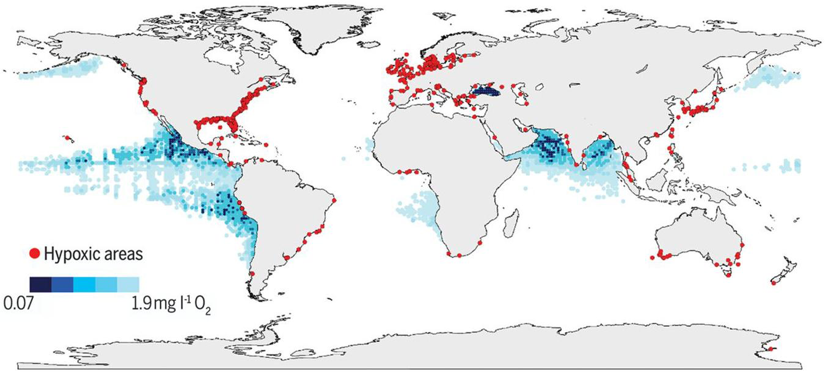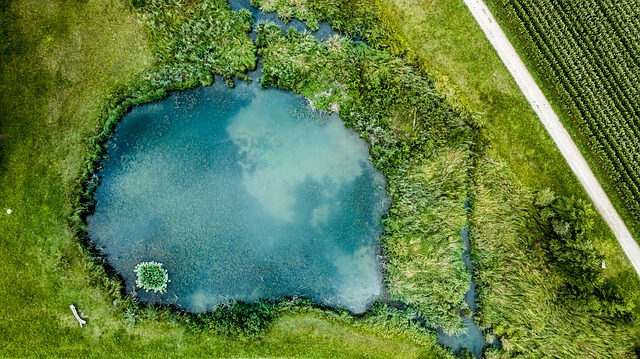Since the 1950s eutrophication of water bodies has been recognized as a critical worldwide problem. Eutrophication causes degradation of the aquatic environment through changes in the composition of species, harmful algae plants or bottom anoxia (Boeykens et al., 2017). These changes leave a strong imprint on biogeochemical and ecological processes that alter ecosystem community structure (Zamparas et al., 2015). Population growth, land-use intensification, and municipal/industrial sewage discharge overload the aquatic ecosystems with nutrients (Zamparas and Zacharias, 2014), intensifying the problem.
Eutrophication affects the quality of all water bodies and coastal areas (Zhou et al., 2020). Lagoons, lakes and other closed water bodies are the most affected (Dunalska et al., 2018; Liu et al., 2020; Yu et al., 2020). The Black Sea is an example of a strongly affected water body, including many eutrophic and anoxic zones. Danube River contaminants generated the dead zone and, from the 1960s to 1989, several sources contributed a huge input of nutrient to watersheds. The sources include rising fossil fuel use, NOx atmospheric input, intensive fertilizer use in farming practices, and sewage to water systems. This resulted in the loss of fisheries and marine habitats, and reduced tourism.

Recognising the urgent need to protect and restore their Water Bodies, the European Member States committed to biological and chemical monitoring of their quality through the Water Framework Directive (WFD) 2000/60. In particular, the EU recognizes that eutrophication and anoxia cannot be treated by reducing nutrient input (N or P) from river catchments (Smith and Schindler, 2009; Zamparas et al., 2015)alone. Therefore, it introduced the new concept of “overall ecological status”, aiming at monitoring and controlling the status of suffering areas through a holistic approachthat combines biological and chemical control actions. Indicating the potential of such an approach, deliberate efforts to restore water quality along the Baltic Sea coast with a combination of improved wastewater treatment, pollution reduction and regulation efforts have led to a beginning of recovery of that ecosystem since 1990.
BLUE-GREENWAY project is an example of a holistic approachfor restoring the eutrophic and anoxic closed water bodies. The project focuses on restoring eutrophic ecosystems while targeting land-based capacity management, for land-water integrated remediation. BLUE-GREENWAY autonomous platform combines 1) actions for eco-friendly treatment of water bodies to treat eutrophication and anoxia, 2) actions directing local groups in implementing best practices by aquatic quality status, thus preventing polluting land output. Two pilots run in AitolikoLagoon, Greece, and Liopetri, Cyprus. In the long run, BLUE-GREENWAY practices will build community resilience and reduce disaster risk, resulting in a sustainable, cost-effective integrated treatment. Supported areas will gain and transfer knowledge, so more regions benefit. Innovative methods will contribute to circular economy practices.
References
Boeykens, S.P., Piol, M.N., Samudio Legal, L., Saralegui, A.B., Vázquez, C., 2017. Eutrophication decrease: Phosphate adsorption processes in presence of nitrates. J. Environ. Manage. 203, 888–895. https://doi.org/10.1016/j.jenvman.2017.05.026
Breitburg, D., Levin, L.A., Oschlies, A., Grégoire, M., Chavez, F.P., Conley, D.J., Garçon, V., Gilbert, D., Gutiérrez, D., Isensee, K., Jacinto, G.S., Limburg, K.E., Montes, I., Naqvi, S.W.A., Pitcher, G.C., Rabalais, N.N., Roman, M.R., Rose, K.A., Seibel, B.A., Telszewski, M., Yasuhara, M., Zhang, J., 2018. Declining oxygen in the global ocean and coastal waters. Science.359. https://doi.org/10.1126/science.aam7240
Dunalska, J.A., Napiórkowska-Krzebietke, A., Ławniczak-Malińska, A., Bogacka-Kapusta, E., Wiśniewski, G., 2018. Restoration of flow-through lakes – Theory and practice. Ecohydrol. Hydrobiol. 18, 379–390. https://doi.org/10.1016/j.ecohyd.2018.06.009
Liu, B., Chen, S., Liu, H., Guan, Y., 2020. Changes in the ratio of benthic to planktonic diatoms to eutrophication status of Muskegon Lake through time: Implications for a valuable indicator on water quality. Ecol. Indic. https://doi.org/10.1016/j.ecolind.2020.106284
Smith, V.H., Schindler, D.W., 2009. Eutrophication science: where do we go from here? Trends Ecol. Evol. 24, 201–207. https://doi.org/10.1016/j.tree.2008.11.009
Yu, C., Li, Z., Xu, Z., Yang, Z., 2020. Lake recovery from eutrophication: Quantitative response of trophic states to anthropogenic influences. Ecol. Eng. 143. https://doi.org/10.1016/j.ecoleng.2019.105697
Zamparas, M., Drosos, M., Deligiannakis, Y., Zacharias, I., 2015. Eutrophication control using a novel bentonite humic-acid composite material BephosTM. J. Environ. Chem. Eng. 3, 3030–3036. https://doi.org/10.1016/j.jece.2014.12.013
Zamparas, M., Zacharias, I., 2014. Restoration of eutrophic freshwater by managing internal nutrient loads. A review. Sci. Total Environ. 496, 551–562. https://doi.org/10.1016/j.scitotenv.2014.07.076
Zhou, Yun, Wang, L., Zhou, Yanyan, Mao, X. zhong, 2020. Eutrophication control strategies for highly anthropogenic influenced coastal waters. Sci. Total Environ. https://doi.org/10.1016/j.scitotenv.2019.135760


